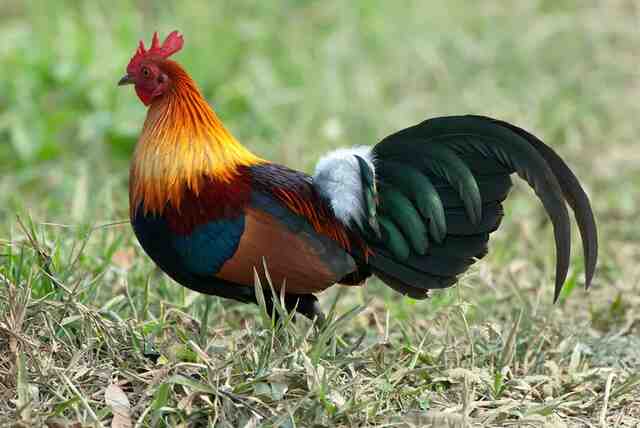Gallus gallus
IUCN
LCBasic Information
Scientific classification
- name:Gallus gallus
- Scientific Name:Gallus gallus,Red Junglefowl,Camellia Chicken
- Outline:Landfowl
- Family:Galliformes Phasianidae Gallus
Vital signs
- length:41-71cm
- Weight:550-1050g
- lifetime:8-13years
Feature
The wild ancestor of the domestic chicken
Distribution and Habitat
Resident: Bhutan and East Timor.
Breeding: Bangladesh, Cambodia, China, India, Indonesia, Lao People's Democratic Republic, Malaysia, Myanmar, Nepal, Pakistan, Philippines, Singapore, Thailand and Vietnam.
Introduced (resident): Dominica, Fiji, Jamaica and Puerto Rico.
Introduced (breeding): Australia, Marshall Islands, Micronesia, Nauru, Northern Mariana Islands, Palau, United States (Hawaii Island).
In China, it is mainly distributed in Luxi, Yongde, Zhenkang, Gengma, Shuangjiang, Ximeng, Jinghong, Menghai, Mengla, Simao, Jingdong, Luchun, Jinping, Hekou and Funing in Yunnan, Jingxi, Baise, Napo, Bama, Chongzuo, Longzhou, Ningming, Pingxiang, Daxin, Tiandeng, Fangcheng, Shangsi, Wuming, Yongning, Shanglin, Jixian, Cenxi, Mashan, Tianlin, Bobai, Hongshuihe and other places in Guangxi, Xuwen in Guangdong, Bawangling, Diaoluoshan, Wenchang, Qionghai, Baisha, Wanning, Ledong, Qiongzhong, Yinggeling, Jianfengling, Dongfang, Baoting and Lingshui in Hainan, all of which are
Appearance
The male bird has gorgeous feathers; there is a fleshy crest on the top of the head, and one or a pair of fleshy wattles under the throat; the face and throat are almost completely exposed; the wings are short and round; the first primary flight feather is much shorter than the 10th, and the second primary flight feather is much shorter than the 10th. The pieces are between the 8th and 10th pieces, with the 5th-6th pieces being slightly longer. Most of the tails have 14 or 16 tail feathers, which are flat on the sides; the central pair of tail feathers is specially extended, about twice as long as the second pair, and almost three times as long as the outermost tail feathers; the feather stems are easy to bend, so they have a sickle shape. And drooping; the longest upper tail coverts are also similar, but shorter. Feet set long. The tarsometatarsus is longer than the middle toe with claws, and has a long and curved sharp spur.
The female bird is smaller in size; its feathers are dul
Details
Red Junglefowl, also known as "junglefowl", has 5 subspecies and is a tropical forest bird.

Except during the breeding season, red junglefowl often live in groups, mostly in small groups of 3-5 or 6-7, and sometimes in large groups of 10-20. They are alert and timid. When they see people or hear noises, they quickly run into the forest or bushes to escape. When in danger, they also flap their wings and fly, each time flying tens to hundreds of meters away, and continue to escape after landing. They roost in trees at night.
Red junglefowl are omnivorous animals, mainly feeding on plant leaves, flowers, young shoots, tender branches, young bamboo shoots, strawberries, figs, grass seeds, berries and seeds. Sometimes they also go to cultivated land to peck at grains, and even go to cultivated land near villages to forage with domestic chickens. The foraging method is also similar to that of domestic chickens, using claws to dig and beaks to peck, often foraging while walking, especially in the morning and evening when foraging activities are most frequent. In addition to plant food, junglefowl also eat various insects and insect larvae and other animal food.
The breeding season of the red junglefowl is from February to May. After entering the breeding season, the male bird calls frequently, often making a cry similar to "E-E-E", which sounds like "two camellia flowers", so many places in Yunnan, China call the red junglefowl Camellia chicken. It mainly nests in dense forests with well-developed shrubs and less interference under the forest, and also nests in small forests near villages. The nest is mostly placed at the foot of a tree or on the ground in the bushes and grass. The nest is very simple, usually a small pit on the ground, or the parent bird digs a shallow pit on the ground and pads it with leaves and feathers. Sometimes it lays eggs directly on the ground in the bushes. Each nest lays 6-8 eggs, occasionally as few as 4 and as many as 12. The eggs are light brown-white or earthy yellow, smooth and spotless, oval, and the size is 42-48 mm × 31-36 mm. After all the eggs are laid, they begin to incubate, which is undertaken by the female bird. The incubation period is 19-21 days. The chicks mature early and can move around with the female soon after hatching.
Listed in the "Red List of Endangered Species of the World Conservation Union" (IUCN) 2016 ver3.1-Least Concern (LC).
Listed in the second level of China's "National Key Protected Wildlife List" (February 5, 2021).
Protect wildlife and eliminate game.
Maintaining ecological balance is everyone's responsibility!








